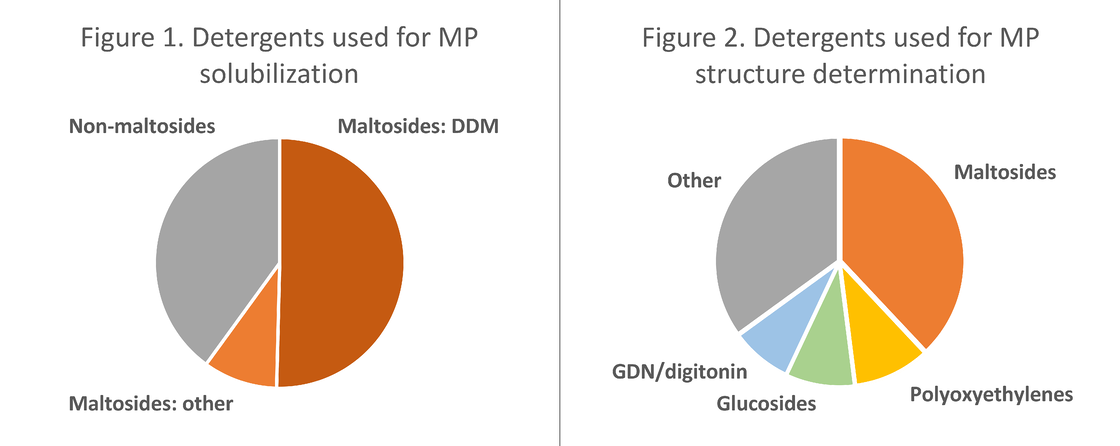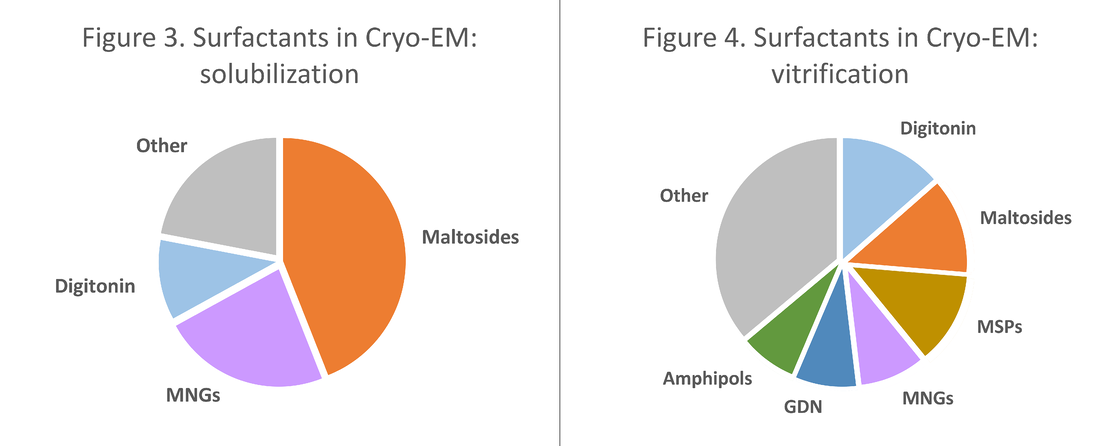Anatrace社 Anatrace Products | A must-read for membrane protein structure aficionados!
| この製品に関するご意見・ご照会・お問合せはこちら
A must-read for membrane protein structure aficionados!
Need references for your membrane protein structures? Recently, our team at Anatrace came across two peer-reviewed articles that summarize current applications of popular detergents and surfactants in the field of structural biology and serve as excellent references for existing research. In this newsletter, we’d like to showcase these articles as abstracts and share some exciting innovations in the membrane protein research space!
Structural biologists know that choosing the right detergent for a specific membrane protein (MP) is not a trivial process. With numerous varieties of surfactants commercially available, it becomes ever more complicated to predict which will be the best option in any given research case. Scientists usually screen several detergents to find the best one for the job, starting with the most versatile (like DDM) options, then turning towards other molecules. The search becomes even more complicated when your detergent of choice can only be used in certain steps of X-ray crystallography and Cryo-EM sample preparation workflows. With all these considerations, it’s no wonder there are so many options available—and that making the right choice involves so many tests!
A wealth of publications have been accumulated on solved MP structures to assist in the selection process, but to derive effective conclusions the data must be analyzed and organized. Fortunately, for the structural biology community, the authors of the papers discussed below have carried out this formidable job.
Choy et al. [1] examined 702 structures from the MP structure database “Membrane Proteins of Known 3D Structure”, created and curated by the Stephen White group [2]. The authors then classified detergent usage by different steps (solubilization, structure determination) in the workflow. Some of the trends they observed can be found in Figures 1 and 2.
Choy et al. uncovered various interesting associations between structure determination technique (Cryo-EM, LCP, vapor diffusion, NMR), protein origin (Eukaryotic, Prokaryotic), protein type (ABC transporters, GPCRs, etc.), and predominantly used detergent conditions for solubilization and structural work. This complex data is presented in a lucid and graphical manner throughout the study. It is easy to see that the vast majority of GPCR structures were solved using X-ray crystallography with maltoside+CHS as both the predominant solubilization agent and the main detergent used in structure determination, with MNG+CHS mix taking second place. This paper is an invaluable guide for anyone setting out to solve a membrane protein structure.
The second study, by Le Bon et al. [3], focused exclusively on surfactants used in Cryo-EM approach. The authors analyzed 604 structures solved by single-particle Cryo-EM from the same database maintained at UC Irvine [2] and looked at surfactants as a function of the Cryo-EM workflow step. No obvious overall leader emerges here, but the authors outline some clear trends, as seen in Figures 3 and 4.
This analysis of surfactant exchange between purification and vitrification highlights the benefits of isolated detergents as well as those that work best in “teams”. As an example, in 70% of cases maltosides were substituted for MSPs, APols, digitonin, or GDN. Notably, MNGs are most likely to work successfully without exchange. Le Bon et al. also discussed the impact of surfactants on Cryo-EM image quality and vitrification. They found and studied cases of protein structures solved using several different surfactants. Moreover, the authors describe in detail the advantages and disadvantages of novel APol and non-detergent strategy solutions and provide future direction concerning upcoming molecules.
Anatrace is amazed by these recent breakthroughs, and we’re excited to be a part of current and future advancements in the field. We’re committed to providing the best solutions we can, never compromising the high standards of quality and purity of our products.
[1] Choy, B. C., Cater, R. J., Mancia, F. & Pryor, E. E. A 10-year meta-analysis of membrane protein structural biology: Detergents, membrane mimetics, and structure determination techniques. Biochimica Et Biophysica Acta Bba - Biomembr 1863, 183533 (2021). DOI: https://doi.org/10.1016/j.bbamem.2020.183533 [2] Database “Membrane Proteins of Known 3D Structure” https://blanco.biomol.uci.edu/mpstruc/ [3] Le Bon, C., Michon, B., Popot, J.-L. & Zoonens, M. Amphipathic environments for determining the structure of membrane proteins by single-particle electron cryo-microscopy. Q Rev Biophys 54, e6 (2021). DOI: https://doi.org/10.1017/S0033583521000044
|
Fount of Information は、新商品、新規取扱メーカーなどの情報をいち早く紹介するコンテンツです。情報発信のスピードを重視しているコンテンツのため、現時点で法規制や取り扱いを確認できていない商品、定価を設定できていない商品があります。ご要望やご照会を受けた商品について、法令整備や在庫の充実を図ります。






